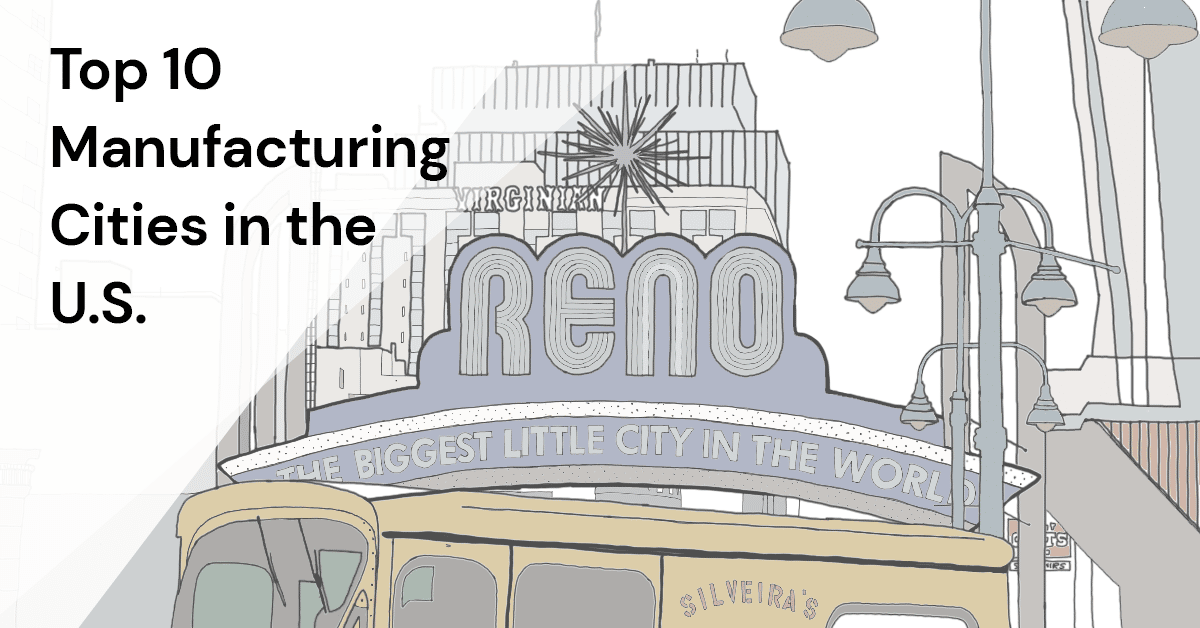
Manufacturing Industry Overview
Before we can talk about the largest manufacturing cities in the U.S., we must take a look at the manufacturing industry as a whole. This has been a hot topic in the news the last few years. As innovation progressed post-WWII, the percentage of jobs in the manufacturing industry has declined from nearly 40% (the manufacturing peak at the height of WWII) to just over 8% today. The significant decrease comes from technological advances that made production more efficient over the years. But now that international supply chains have become tremendously unreliable, the demand for domestic manufacturing is rising again. These shifts have encouraged higher wages and more jobs to be filled across the country than the industry has seen in a while.
The skilled manufacturing tradespeople of the world have a lot of options to choose from. You might be surprised to see which spots are now the 10 largest manufacturing cities. We thought it might be useful to share what cities across the U.S. are leading the manufacturing resurgence. Why are they becoming so popular for manufacturers? What else do these cities offer besides a job? Keep reading to find out and get our take on the hottest cities for manufacturing & why we chose them!
Ranking the Major Manufacturing Spots
NCW’s Top Ten consists of top manufacturing cities in the U.S., with respect to other amenities the city has to offer. We utilized AdvisorSmith’s recent study of 294 U.S. cities where they named the top manufacturing cities for the following criteria: manufacturing output growth rate, manufacturing output per capita, manufacturing location quotient, and the manufacturing employment growth rate.
We wanted to build on that data by ranking the cities in order of how likely we would be to move to each of those cities (aside from the fact that manufacturing opportunities are prominent). We considered access to good education, crime rates, arts & entertainment, outdoor activities, sustainability, and community initiatives along with manufacturing growth rates and workforce share when looking at each of these cities.
Largest Manufacturing Cities, Ranked by NCW
#1 – Reno, NV

Known as the “Biggest Little City in the World,” Reno has become a new hub for leading tech companies and thus, manufacturing. This “little city” has become sought after for business ventures because there is no individual or business income tax. Aside from the financial benefits, Reno boasts a beautiful riverfront promenade, good food, the annual Burning Man music festival, and proximity to adventure. It rests along the Sierra Nevada, which is great for snow sports–and is less than an hour drive from the beautiful Lake Tahoe.
Facts:
Manufacturing Employment Growth (2010-2020) – 109.4%
Manufacturing Share of total Employment (2020) – 8.3%
Population – 250,903
Median Home Value – $361,100
Median Household Income – $61,860
Why we picked it: It’s the best of both worlds (big and small city perks), has much to offer outdoors, and no income tax!
#2 – Twin Falls, ID

This outdoor enthusiast’s paradise is part of the “Magic Valley,” located in Southern Idaho. “Magic Valley” is the nickname given to the Snake River Plains that, just 75 years ago, were virtually uninhabitable. But then, magic happened–irrigation. Hence the nickname. Twin Falls quickly became lush with farmland and produce, including potatoes. Today, it offers much in outdoor activities, water sports, snow sports and scenery.
Facts:
Manufacturing Employment Growth (2010-2020) – 43.4%
Manufacturing Share of total Employment (2020) – 10.4%
Population – 49,819
Median Home Value – $175,900
Median Household Income – $50,839
Why we picked it: It’s an outdoorsman/outdoorswoman’s paradise that shouldn’t exist, but magically does.
#3 – Fort Collins, CO
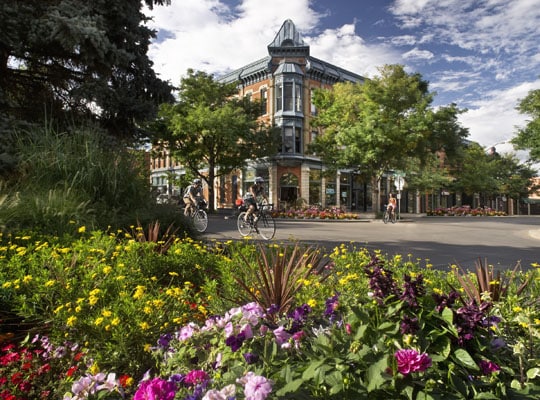
If you’re looking for a family-friendly place to live, look no further. Fort Collins is consistently voted the best city for families in Colorado. It makes sense considering they are also one of the happiest and greenest cities in the United States too. Excellent education isn’t hard to find here either. Between the top-notch public schools and Colorado State University, your children might never leave the city. The city is saturated with big tech companies (that make manufacturing so necessary), microbreweries, and outdoor amenities. And of course, there’s the mountains.
Facts:
Manufacturing Employment Growth (2010-2020) – 30.9%
Manufacturing Share of total Employment (2020) – 6.6%
Population – 166,069
Median Home Value – $398,800
Median Household Income – $70,528
Why we picked it: It’s the perfect for families, environmentally-conscious, and has top-ranked education.
#4 – Palm Bay – Melbourne – Titusville, FL
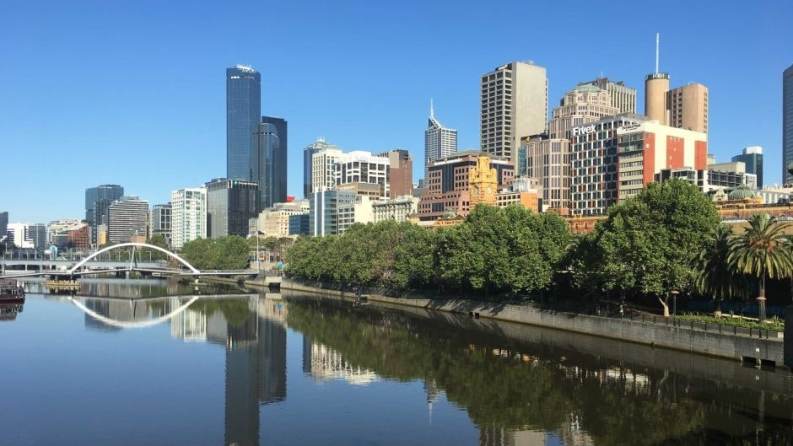
If you’re into space, this is the spot for you. This small metropolis on the Space Coast is home to several aerospace and defense companies as well as some big technology. If you’ve ever wanted to move to Florida without paying a fortune, this is a great place to start. It is known as one of the best cities to buy a house. Abundance of jobs, beaches, and just a short drive to some of the country’s top vacation destinations make this spot ideal for families too.
Facts:
Manufacturing Employment Growth (2010-2020) – 39.6%
Manufacturing Share of total Employment (2020) – 9.9%
Population – 113,751 (Palm Bay), 82,281 (Melbourne), 46,307 (Titusville)
Median Home Value – $172,200 (Palm Bay), $186,000 (Melbourne), $160,700 (Titusville)
Median Household Income – $52,435 (Palm Bay), $51,934 (Melbourne), $48,757 (Titusville)
Why we picked it: It’s Florida. There are beaches, palm trees, and fresh seafood. Plus, the cost of a home is extremely reasonable for the Sunshine State.
#5 – Kalamazoo – Portage, MI
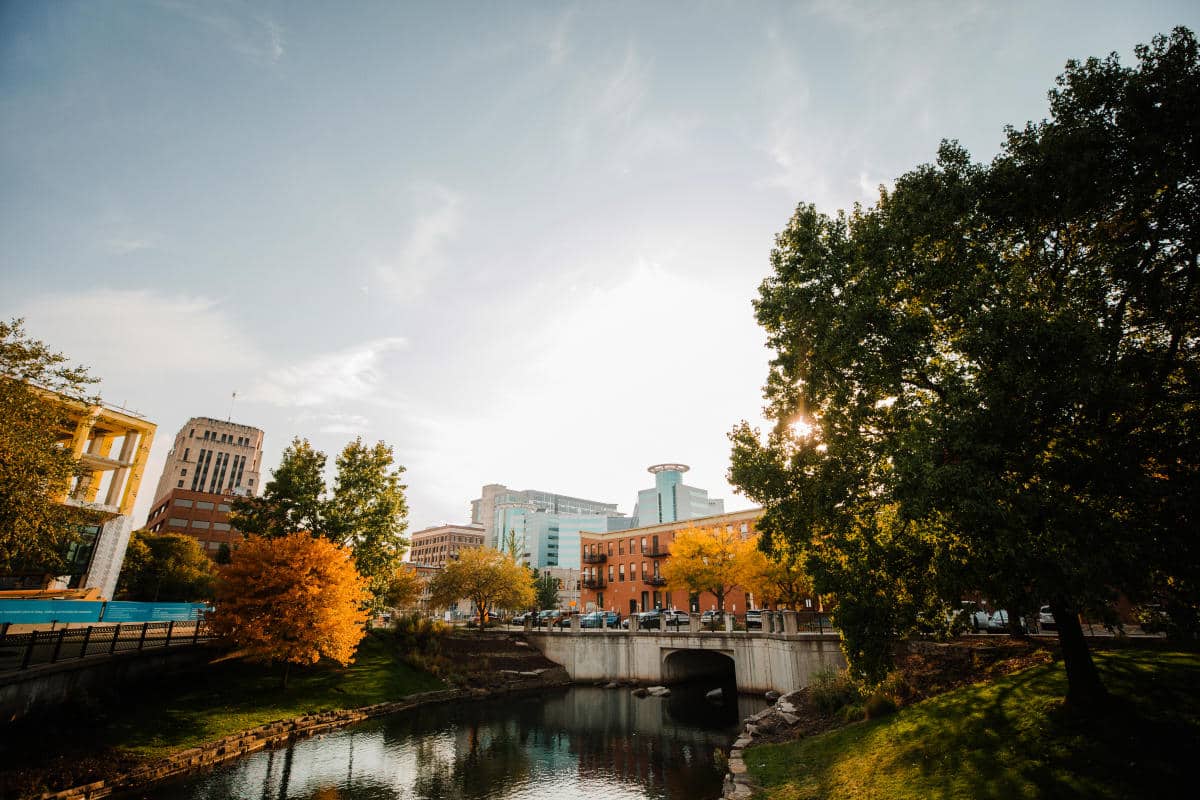
Pure Michigan may not have the ocean, but Lake Michigan is about as close as it gets. Just a short drive away from the coast of Lake Michigan sit Kalamazoo and it’s sister city, Portage. If you’re looking for a small city with big city amenities, this is a great place. Kalamazoo and Portage have some major manufacturers that employ 13% of the population. You may recognize some of these, like Stryker or Pfizer. This area is also a hotspot for education. The “Kalamazoo Promise” guarantees 100% of in-state, public community college or university tuition paid for students that graduate from a Kalamazoo public school while meeting basic requirements. Several of the participating schools offer apprenticeships and skilled trade programs. But there is also the option to go to a large school like University of Michigan, Michigan State, Central Michigan University, and so many more. Kalamazoo has the right idea.
Facts:
Manufacturing Employment Growth (2010-2020) – 21.6%
Manufacturing Share of total Employment (2020) – 13.3%
Population – 76,106
Median Home Value – $113,700
Median Household Income – $43,222
Why we picked it: Leading medical manufacturers call it home, and the city invests in its residents’ education making it a great city for families with children.
#6 – Vallejo, CA

If you’ve seen the cost of living in the Bay Area today, you know that it is one of the most expensive (if not the most expensive) places to live in the country. But if you’ve been there, you can see why. Abundance of tech industry jobs, great food, a diverse population, amazing weather, beautiful landscapes, and rich history. Bay Area residents are quickly discovering California’s secret, Vallejo. It mimics the Bay in all the right ways without the high price tag. As you can see, the median home value is shockingly reasonable compared to San Francisco’s alarming $1.488 million. Sitting just northeast of San Francisco, Vallejo is nestled in the San Pablo Bay, just 20 minutes from the Napa Valley. U.S. News ranked Vallejo as the 9th best place to live in California, probably because the cost of living is lower than the California average.
Facts:
Manufacturing Employment Growth (2010-2020) – 35.4%
Manufacturing Share of total Employment (2020) – 6.8%
Population – 121,275
Median Home Value – $190,100
Median Household Income – $73,869
Why we picked it: It has the Bay Area flavor, without the price tag. Napa is step away and you can still experience San Francisco without having to pay the fortune it costs to be a resident there.
#7 – Lake Charles, LA
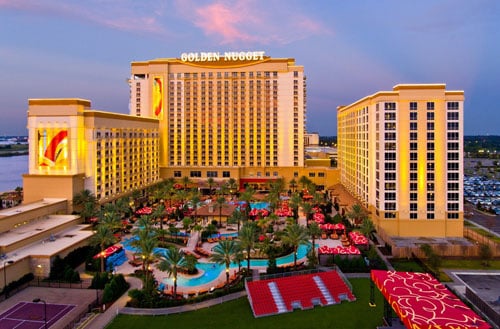
This city that sits between Houston and New Orleans calls itself “Louisiana’s Playground.” Even after southwestern Louisiana’s category 4 hurricane, Hurricane Laura, wreaked havoc on the Lake Charles community in 2020, it hasn’t missed a beat. A vibrant mix of Texas flavor and Cajun spice sets it apart from other Louisiana cities. This “miniature Vegas” has three beautiful casino resorts, big-city entertainment and arts, and the great outdoors. The 180-mile Creole Nature Trail (“Louisiana’s Outback”) is one of the most popular outdoor attractions for it’s wildlife habitats and estuaries—perfect for fishing, boating, bird watching and crab hunting. And of course, you’re never far from live music in Louisiana. Lake Charles is the best of New Orleans without the intense crowds and dirty streets.
Facts:
Manufacturing Employment Growth (2010-2020) – 21.4%
Manufacturing Share of total Employment (2020) – 8.9%
Population – 77,832
Median Home Value – $155,700
Median Household Income – $44,785
Why we picked it: It’s a mini version of New Orleans, combined with Texas and Vegas. It’s a charming riverfront community with something for everyone!
#8 – Tuscaloosa, AL
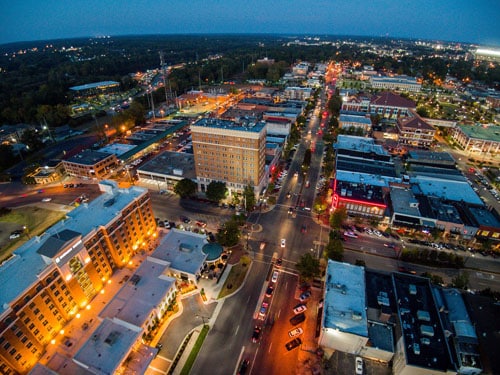
Football fanatics, this pick is for you. “T-Town,” or “Title Town,” as it is often referred to by locals, is covered in the crimson tide. This historic community is home to the legendary University of Alabama—roll tide! It sits along the Black Warrior River, that feeds popular reservoirs abundant in bass fish. If you aren’t into the fishing thing, the Riverwalk along the Southern banks is a great place to walk, ride a bike, or enjoy beautiful views (like the historic train trestle bridge). If you’re looking for a career in manufacturing, love fishing, enjoy going to football games and participating in outdoor activities—oh, and don’t mind the summer heat—Tuscaloosa is your perfect match.
Facts:
Manufacturing Employment Growth (2010-2020) – 27.8%
Manufacturing Share of total Employment (2020) – 13%
Population – 100,633
Median Home Value – $404,600
Median Household Income – $44,507
Why we picked it: Because football and fishing are worth suffering through some heat.
#9 – Elkhart, IN
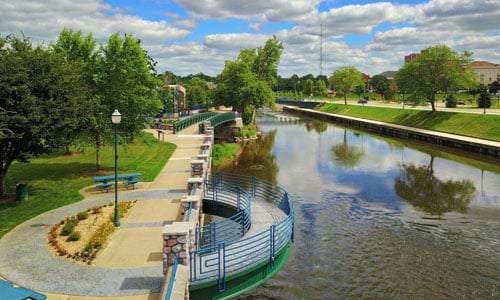
We had to include the RV Capital of the world in this list, of course. Especially since it is so near and dear to our headquarters and our hearts. The “City with a Heart” or “Hart city,” is home to the largest recreational vehicle manufacturers in the world, making it a major hub for skilled tradespeople. It’s community is rich in economic and ethnic diversity, especially in Indiana. This growing community may not have as many amenities as other cities on this list, but you shouldn’t sleep on its 9 museums, Simonton Lake, the world’s only comic book and superhero museum (Hall of Heroes), and proximity to large metropolitan areas (Chicago, South Bend, Fort Wayne, and Kalamazoo).
Facts:
Manufacturing Employment Growth (2010-2020) – 38%
Manufacturing Share of total Employment (2020) – 13.7%
Population – 52,657
Median Home Value – $96,500
Median Household Income – $40,101
Why we picked it: Because it is a great central location for manufacturing hot spots. It is rich in ethnic & economic diversity, historic charm, and small businesses.
#10 – Kankakee, IL
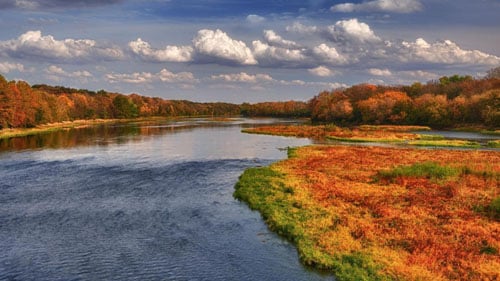
While Kankakee has one of the higher combinations of manufacturing employment growth and total share of the workforce, it landed last on our list for a reason. If you are familiar with Kankakee, it’s probably because you passed it on your way to Chicago. As the smallest city on the list, it has managed to put up big numbers in manufacturing growth over the last 10 years. While Illinois has struggled to retain residents and businesses due to high costs of living/operating, Kankakee remains an affordable option with a cost of living that is lower than the national average. We might see this community climb the list in years to come if the investments they are making to improve retention, are successful without driving up costs too much. Projects like the Kankakee Riverfront Master Plan could really impact its desirability and growth at a pivotal time. Only 60 miles from Chicago, Kankakee has a lot of untapped potential.
Facts:
Manufacturing Employment Growth (2010-2020) – 58.7%
Manufacturing Share of total Employment (2020) – 13.7%
Population – 25,818
Median Home Value – $87,000
Median Household Income – $38,763
Why we picked it: It’s one of the cheapest places to live in Illinois, while still being relatively close to Chicago. It could be an up-and-coming place to move if the city continues to invest in infrastructure and curb appeal on the riverfront.
Want to see what jobs we have available in these locations? Check out our current postings!
